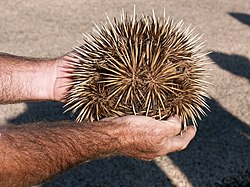
Volvation (from Latin volvere "roll", and the suffix -(a)tion; sometimes called enrolment or conglobation) is a defensive behavior of certain animals in which the animal rolls its body into a ball, presenting only the hardest parts of its integument (the animal's "armor") or its spines to predators.
Contents
Mammals such as pangolins (Manidae) and hedgehogs (Erinaceidae) exhibit the ability to conglobate. [1] Armadillos in the genus Tolypeutes (South American three-banded armadillos) are able to roll into a defensive ball, but the nine-banded armadillo and other species have too many plates to do so. [2]
Earthworms may volvate during periods of extreme heat or drought. Among pill millipedes, volvation is a protection against both external threats and against dehydration. [3] At least eight families of flat-backed millipedes are known to practice true volvation; these are described as oniscoid (woodlouse-like). [4]
The pauropod family Sphaeropauropodidae has the ability to coil completely into a tight sphere. [5]
Woodlice or pillbugs (Armadillidae) curl themselves into "pills" not only for defense, but also to conserve moisture while resting or sleeping, because they must keep their pseudotrachaea ("gills") wet. Volvation is common for subterranean isopods, but only Caecosphaeroma burgundum is able to roll into a hermetic sphere without any outward projections. [6]
Multi-shelled chitons also volvate, although evidence suggests that they do not use this behavior as an anti-predatory defense but rather as a form of locomotion. [1]
In vertebrates, an animal's decision to volvate is mediated by the periaqueductal gray region. [7]










